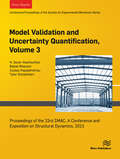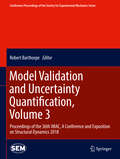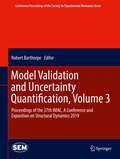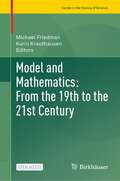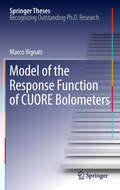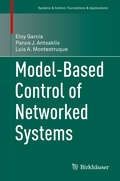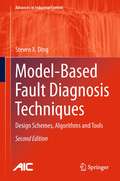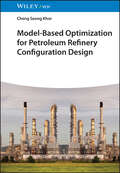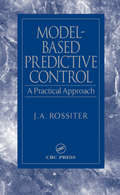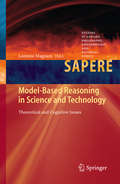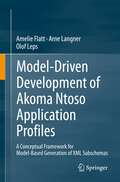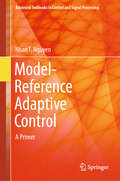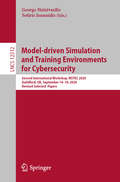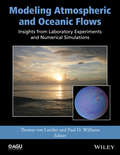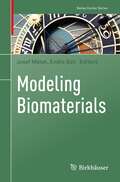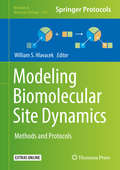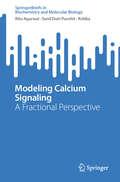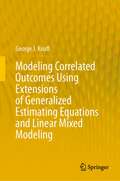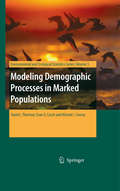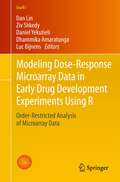- Table View
- List View
Model Validation and Uncertainty Quantification, Volume 3: Proceedings of the 33rd IMAC, A Conference and Exposition on Structural Dynamics, 2015
by Costas Papadimitriou Babak Moaveni Tyler Schoenherr H. Sezer AtamturkturModel Validation and Uncertainty Quantification, Volume 3. Proceedings of the 33rd IMAC, A Conference and Exposition on Balancing Simulation and Testing, 2015, the third volume of ten from the Conference brings together contributions to this important area of research and engineering. The collection presents early findings and case studies on fundamental and applied aspects of Structural Dynamics, including papers on: Uncertainty Quantification & Model Validation Uncertainty Propagation in Structural Dynamics Bayesian & Markov Chain Monte Carlo Methods Practical Applications of MVUQ Advances in MVUQ & Model Updating.
Model Validation and Uncertainty Quantification, Volume 3: Proceedings of the 36th IMAC, A Conference and Exposition on Structural Dynamics 2018 (Conference Proceedings of the Society for Experimental Mechanics Series)
by Robert BarthorpeModel Validation and Uncertainty Quantification, Volume 3: Proceedings of the 36th IMAC, A Conference and Exposition on Structural Dynamics, 2018, the third volume of nine from the Conference brings together contributions to this important area of research and engineering. The collection presents early findings and case studies on fundamental and applied aspects of Model Validation and Uncertainty Quantification, including papers on:Uncertainty Quantification in Material ModelsUncertainty Propagation in Structural DynamicsPractical Applications of MVUQAdvances in Model Validation & Uncertainty Quantification: Model UpdatingModel Validation & Uncertainty Quantification: Industrial ApplicationsControlling UncertaintyUncertainty in Early Stage DesignModeling of Musical InstrumentsOverview of Model Validation and Uncertainty
Model Validation and Uncertainty Quantification, Volume 3: Proceedings of the 37th IMAC, A Conference and Exposition on Structural Dynamics 2019 (Conference Proceedings of the Society for Experimental Mechanics Series)
by Robert BarthorpeModel Validation and Uncertainty Quantification, Volume 3: Proceedings of the 37th IMAC, A Conference and Exposition on Structural Dynamics, 2019, the third volume of eight from the Conference brings together contributions to this important area of research and engineering. The collection presents early findings and case studies on fundamental and applied aspects of Model Validation and Uncertainty Quantification, including papers on: Inverse Problems and Uncertainty Quantification Controlling Uncertainty Validation of Models for Operating Environments Model Validation & Uncertainty Quantification: Decision Making Uncertainty Quantification in Structural Dynamics Uncertainty in Early Stage Design Computational and Uncertainty Quantification Tools
Model and Mathematics: From the 19th to the 21st Century (Trends in the History of Science)
by Michael Friedman Karin KrauthausenThis open access book collects the historical and medial perspectives of a systematic and epistemological analysis of the complicated, multifaceted relationship between model and mathematics, ranging from, for example, the physical mathematical models of the 19th century to the simulation and digital modelling of the 21st century. The aim of this anthology is to showcase the status of the mathematical model between abstraction and realization, presentation and representation, what is modeled and what models.This book is open access under a CC BY 4.0 license.
Model of the Response Function of CUORE Bolometers
by Marco VignatiLarge mass bolometers are used in particle physics experiments to search for rare processes, like neutrinoless double beta decay and dark matter interactions. In the next years the CUORE experiment (a 1 Ton detector composed by 1000 crystals of TeO2 operated as bolometers in a large cryostat at 10mK) will be the particle physics experiment with the highest chance of discovering the Majorana neutrino, a long standing and yet fundamental question of particle physics. The study presented in this book was performed on the bolometers of the CUORE experiment. The response function of these detectors is not linear in the energy range of interest, and it changes with the operating temperature, worsening the performances. The nonlinearity appeared to be dominated by the thermistor and the biasing circuit used to read the bolometer, and was modeled using few measurable parameters. A method to obtain a linear response is the result of this work. It allows a great improvement of the detector operation and data analysis. With a foreword by Fernando Ferroni.
Model-Based Control of Networked Systems
by Eloy Garcia Panos J. Antsaklis Luis A. MontestruqueThis monograph introduces a class of networked control systems (NCS) called model-based networked control systems (MB-NCS) and presents various architectures and control strategies designed to improve the performance of NCS. The overall performance of NCS considers the appropriate use of network resources, particularly network bandwidth, in conjunction with the desired response of the system being controlled. The book begins with a detailed description of the basic MB-NCS architecture that provides stability conditions in terms of state feedback updates. It also covers typical problems in NCS such as network delays, network scheduling, and data quantization, as well as more general control problems such as output feedback control, nonlinear systems stabilization, and tracking control. Key features and topics include: Time-triggered and event-triggered feedback updates Stabilization of uncertain systems subject to time delays, quantization, and extended absence of feedback Optimal control analysis and design of model-based networked systems Parameter identification and adaptive stabilization of systems controlled over networks The MB-NCS approach to decentralized control of distributed systems Model-Based Control of Networked Systems will appeal to researchers, practitioners, and graduate students interested in the control of networked systems, distributed systems, and systems with limited feedback.
Model-Based Fault Diagnosis Techniques
by Steven X. DingGuaranteeing a high system performance over a wide operating range is an important issue surrounding the design of automatic control systems with successively increasing complexity. As a key technology in the search for a solution, advanced fault detection and identification (FDI) is receiving considerable attention. This book introduces basic model-based FDI schemes, advanced analysis and design algorithms, and mathematical and control-theoretic tools. This second edition of Model-Based Fault Diagnosis Techniques contains: * new material on fault isolation and identification and alarm management; * extended and revised treatment of systematic threshold determination for systems with both deterministic unknown inputs and stochastic noises; * addition of the continuously-stirred tank heater as a representative process-industrial benchmark; and * enhanced discussion of residual evaluation which now deals with stochastic processes. Model-based Fault Diagnosis Techniques will interest academic researchers working in fault identification and diagnosis and as a text it is suitable for graduate students in a formal university-based course or as a self-study aid for practising engineers working with automatic control or mechatronic systems from backgrounds as diverse as chemical process and power engineering.
Model-Based Optimization for Petroleum Refinery Configuration Design
by Cheng Seong KhorModel-Based Optimization for Petroleum Refinery Configuration Design An accessible, easy-to-read introduction to the methods of mixed-integer optimization, with practical applications, real-world operational data, and case studies Interest in model-based approaches for optimizing the design of petroleum refineries has increased throughout the industry in recent years. Mathematical optimization based on mixed-integer programming has brought about the superstructure optimization method for synthesizing petroleum refinery configurations from multiple topological alternatives. Model-Based Optimization for Petroleum Refinery Configuration Design presents a detailed introduction to the use of mathematical optimization to solve both linear and nonlinear problems in the refining industry. The book opens with an overview of petroleum refining processes, basic concepts in mathematical programming, and applications of mathematical programming for refinery optimization. Subsequent chapters address superstructure representations of topological alternatives, mathematical formulation, solution strategies, and various modeling frameworks. Practical case studies demonstrate refinery configuration design, refinery retrofitting, and real-world issues and considerations. Presents linear, nonlinear, and mixed-integer programming approaches applicable to both new and existing petroleum refineriesHighlights the benefits of model-based solutions to refinery configuration design problemsFeatures detailed case studies of the development and implementation of optimization modelsDiscusses economic considerations of heavy oil processing, including cash flow analysis of refinery costs and return on capitalIncludes numerical examples based on real-world operational data and various commercial technologies Model-Based Optimization for Petroleum Refinery Configuration Design is an invaluable resource for researchers, chemical engineers, process and energy engineers, other refining professionals, and advanced chemical engineering students.
Model-Based Predictive Control: A Practical Approach (Control Series)
by J. A. RossiterModel Predictive Control (MPC) has become a widely used methodology across all engineering disciplines, yet there are few books which study this approach. Until now, no book has addressed in detail all key issues in the field including apriori stability and robust stability results. Engineers and MPC researchers now have a volume that provides a complete overview of the theory and practice of MPC as it relates to process and control engineering.Model-Based Predictive Control, A Practical Approach, analyzes predictive control from its base mathematical foundation, but delivers the subject matter in a readable, intuitive style. The author writes in layman's terms, avoiding jargon and using a style that relies upon personal insight into practical applications.This detailed introduction to predictive control introduces basic MPC concepts and demonstrates how they are applied in the design and control of systems, experiments, and industrial processes. The text outlines how to model, provide robustness, handle constraints, ensure feasibility, and guarantee stability. It also details options in regard to algorithms, models, and complexity vs. performance issues.
Model-Based Reasoning in Science and Technology: Theoretical and Cognitive Issues
by Lorenzo MagnaniThis book contains contributions presented during the international conference on Model-Based Reasoning (MBR´012), held on June 21-23 in Sestri Levante, Italy. Interdisciplinary researchers discuss in this volume how scientific cognition and other kinds of cognition make use of models, abduction, and explanatory reasoning in order to produce important or creative changes in theories and concepts. Some of the contributions analyzed the problem of model-based reasoning in technology and stressed the issues of scientific and technological innovation. The book is divided in three main parts: models, mental models, representations; abduction, problem solving and practical reasoning; historical, epistemological and technological issues. The volume is based on the papers that were presented at the international
Model-Based Reasoning, Abductive Cognition, Creativity: Inferences and Models in Science, Logic, Language, and Technology (Studies in Applied Philosophy, Epistemology and Rational Ethics #70)
by Emiliano Ippoliti Lorenzo Magnani Selene ArfiniThis book discusses how scientific and other types of cognition make use of models, abduction, and explanatory reasoning in order to produce important, innovative, and possibly creative changes in theories and concepts. Gathering revised contributions presented at the international conference on Model-Based Reasoning (MBR023), held on June 7–9, 2023 in Rome, Italy, the book addresses various intertwined topics ranging from the epistemology and applications of models also concerning the problem of knowledge production and scientific methodology (information visualization, experimental methods, and design) to the analysis of their role in cognition, decision-making, also with respect to social implications. The problem of model-based cognition is also illustrated taking advantage of recent results regarding problem-solving, abduction, and logic, paying attention to a critique of the dominant and received approaches, to the aim of fostering new discussions and stimulate new ideas. All in all, the book provides researchers and graduate students in the fields of applied philosophy, epistemology, cognitive science, and artificial intelligence alike with an authoritative snapshot of the latest theories and applications of model-based reasoning.
Model-Driven Development of Akoma Ntoso Application Profiles: A Conceptual Framework for Model-Based Generation of XML Subschemas
by Olof Leps Amelie Flatt Arne LangnerThis book presents a model-driven approach for creating a national application profile of the international legislative document standard Akoma Ntoso (AKN). AKN is an XML-based document standard that serves as the basis for modern machine-readable and fully digital legislative and judicial processes. The described model-driven development approach ensures consistent and error-proof application of AKN concepts and types, even when using different software tools. It allows for easy maintenance, is self-documenting, and facilitates stakeholder validation with nontechnical legal experts. The resulting application profile remains fully compliant to and compatible with AKN. For the sake of illustration, the approach is paradigmatically applied to the German federal legislative process, as a corresponding approach was used in the creation of the German AKN application profile, LegalDocML.de. We discuss how the methodology yields a model, schema definition and specification that correspond to the artefacts created by LegalDocML.de, using examples from Germany. The book is of interest to both legal and technical project teams on the cusp of introducing AKN in a legislative domain and intended as a practical guideline for teams preparing to create a custom application profile for their own domain. Furthermore, it can serve as both a resource and an inspiration for similar and yet to be developed methodologies in the public sector, the health sector or in defense, where international standardization and interoperability efforts are to be applied to a local level.
Model-Free Stabilization by Extremum Seeking
by Alexander Scheinker Miroslav KrstićWith this brief, the authors present algorithms for model-free stabilization of unstable dynamic systems. An extremum-seeking algorithm assigns the role of a cost function to the dynamic system's control Lyapunov function (clf) aiming at its minimization. The minimization of the clf drives the clf to zero and achieves asymptotic stabilization. This approach does not rely on, or require knowledge of, the system model. Instead, it employs periodic perturbation signals, along with the clf. The same effect is achieved as by using clf-based feedback laws that profit from modeling knowledge, but in a time-average sense. Rather than use integrals of the systems vector field, we employ Lie-bracket-based (i. e. , derivative-based) averaging. The brief contains numerous examples and applications, including examples with unknown control directions and experiments with charged particle accelerators. It is intended for theoretical control engineers and mathematicians, and practitioners working in various industrial areas and in robotics.
Model-Reference Adaptive Control: A Primer (Advanced Textbooks in Control and Signal Processing)
by Nhan T. NguyenThis textbook provides readers with a good working knowledge of adaptive control theory through applications. It is intended for students beginning masters or doctoral courses, and control practitioners wishing to get up to speed in the subject expeditiously. Readers are taught a wide variety of adaptive control techniques starting with simple methods and extending step-by-step to more complex ones. Stability proofs are provided for all adaptive control techniques without obfuscating reader understanding with excessive mathematics. The book begins with standard model-reference adaptive control (MRAC) for first-order, second-order, and multi-input, multi-output systems. Treatment of least-squares parameter estimation and its extension to MRAC follow, helping readers to gain a different perspective on MRAC. Function approximation with orthogonal polynomials and neural networks, and MRAC using neural networks are also covered. Robustness issues connected with MRAC are discussed, helping the student to appreciate potential pitfalls of the technique. This appreciation is encouraged by drawing parallels between various aspects of robustness and linear time-invariant systems wherever relevant. Following on from the robustness problems is material covering robust adaptive control including standard methods and detailed exposition of recent advances, in particular, the author’s work on optimal control modification. Interesting properties of the new method are illustrated in the design of adaptive systems to meet stability margins. This method has been successfully flight-tested on research aircraft, one of various flight-control applications detailed towards the end of the book along with a hybrid adaptive flight control architecture that combines direct MRAC with least-squares indirect adaptive control. In addition to the applications, understanding is encouraged by the use of end-of-chapter exercises and associated MATLAB® files. Readers will need no more than the standard mathematics for basic control theory such as differential equations and matrix algebra; the book covers the foundations of MRAC and the necessary mathematical preliminaries.
Model-driven Simulation and Training Environments for Cybersecurity: Second International Workshop, MSTEC 2020, Guildford, UK, September 14–18, 2020, Revised Selected Papers (Lecture Notes in Computer Science #12512)
by Sotiris Ioannidis George HatzivasilisThis book constitutes the refereed post-conference proceedings of the Second International Workshop on Model-Driven Simulation and Training Environments for Cybersecurity, MSTEC 2020, held in Guildford, UK, in September 2020 in conjunction with the 24th European Symposium on Research in Computer Security, ESORICS 2020. The conference was held virtually due to the COVID-19 pandemic. The MSTEC Workshop received 20 submissions from which 10 full papers were selected for presentation. The papers are grouped in thematically on: cyber security training modelling; serious games; emulation & simulation studies; attacks; security policies.
Modeling Approaches to Natural Convection in Porous Media
by Yan Su Jane H. DavidsonThis book provides an overview of the field of flow and heat transfer in porous medium and focuses on presentation of a generalized approach to predict drag and convective heat transfer within porous medium of arbitrary microscopic geometry, including reticulated foams and packed beds. Practical numerical methods to solve natural convection problems in porous media will be presented with illustrative applications for filtrations, thermal storage and solar receivers.
Modeling Atmospheric and Oceanic Flows: Insights from Laboratory Experiments and Numerical Simulations
by Paul D. Williams Thomas Von LarcherModeling Atmospheric and Oceanic Flows: Insights from Laboratory Experiments and Numerical Simulations provides a broad overview of recent progress in using laboratory experiments and numerical simulations to model atmospheric and oceanic fluid motions. This volume not only surveys novel research topics in laboratory experimentation, but also highlights recent developments in the corresponding computational simulations. As computing power grows exponentially and better numerical codes are developed, the interplay between numerical simulations and laboratory experiments is gaining paramount importance within the scientific community. The lessons learnt from the laboratory-model comparisons in this volume will act as a source of inspiration for the next generation of experiments and simulations. Modeling Atmospheric and Oceanic Flows will be a valuable resource for graduate students, researchers, and professionals in the fields of geophysics, atmospheric sciences, oceanography, climate science, hydrology, and experimental geosciences.
Modeling Biological Phosphorus Removal in Activated Sludge Systems
by Damir BrdanovicThis text looks at different effects on the process of biological phosphorus removal. Topics include: biological phosphorus removal processes; process and molecular ecological studies; and the effect of potassium limitation on biological phosphorus removal.
Modeling Biomaterials (Nečas Center Series)
by Endre Süli Josef MálekThe investigation of the role of mechanical and mechano-chemical interactions in cellular processes and tissue development is a rapidly growing research field in the life sciences and in biomedical engineering. Quantitative understanding of this important area in the study of biological systems requires the development of adequate mathematical models for the simulation of the evolution of these systems in space and time. Since expertise in various fields is necessary, this calls for a multidisciplinary approach.This edited volume connects basic physical, biological, and physiological concepts to methods for the mathematical modeling of various materials by pursuing a multiscale approach, from subcellular to organ and system level. Written by active researchers, each chapter provides a detailed introduction to a given field, illustrates various approaches to creating models, and explores recent advances and future research perspectives. Topics covered include molecular dynamics simulations of lipid membranes, phenomenological continuum mechanics of tissue growth, and translational cardiovascular modeling. Modeling Biomaterials will be a valuable resource for both non-specialists and experienced researchers from various domains of science, such as applied mathematics, biophysics, computational physiology, and medicine.
Modeling Biomolecular Site Dynamics: Methods And Protocols (Methods In Molecular Biology #1945)
by William S. HlavacekThis volume covers a variety of topics related to the practice of rule-based modeling, a type of mathematical modeling useful for studying biomolecular site dynamics. There is an emphasis on software tools and detailed descriptions of techniques. The chapters in this book discuss topics such as software tools and frameworks for compartmental modeling (Pycellerator, RuleBuilder, Prgy, rxncon, MSMB, and ML-Rules); tools for spatial modeling (Simmune, Smoldyn, MCell-R, SRSim, and CellOrganizer); rule-based models to analyze proteomic data; model annotation; Markov chain aggregation; BioJazz; and methods to identify model parameters (Data2Dynamics, RKappa, and BioNetFit). Written in the highly successful Methods in Molecular Biology series format, chapters include introductions to their respective topics, lists of the necessary resources, step-by-step, readily reproducible protocols, and tips on troubleshooting and avoiding known pitfalls. <p><p> Cutting-edge and thorough, Modeling Biomolecular Site Dynamics: Methods and Protocols is a valuable resource for both the novice and expert rule-based modeler. It will also appeal to systems biologists and help them enhance their studies with easy-to-read and write rule-based models.
Modeling Calcium Signaling: A Fractional Perspective (SpringerBriefs in Biochemistry and Molecular Biology)
by Sunil Dutt Purohit Ritu Agarwal KritikaThis book features chapters written by renowned scientists from various parts of the world, providing an up-to-date survey of submanifold theory, spanning diverse topics and applications. The book covers a wide range of topics such as Chen–Ricci inequalities in differential geometry, optimal inequalities for Casorati curvatures in quaternion geometry, conformal η-Ricci–Yamabe solitons, submersion on statistical metallic structure, solitons in f(R, T)-gravity, metric-affine geometry, generalized Wintgen inequalities, tangent bundles, and Lagrangian submanifolds. Moreover, the book showcases the latest findings on Pythagorean submanifolds and submanifolds of four-dimensional f-manifolds. The chapters in this book delve into numerous problems and conjectures on submanifolds, providing valuable insights for scientists, educators, and graduate students looking to stay updated with the latest developments in the field. With its comprehensive coverage and detailed explanations, this book is an essential resource for anyone interested in submanifold theory.
Modeling Cellular Systems
by Frederik Graw Franziska Matthäus Jürgen PahleThis contributed volume comprises research articles and reviews on topics connected to the mathematical modeling of cellular systems. These contributions cover signaling pathways, stochastic effects, cell motility and mechanics, pattern formation processes, as well as multi-scale approaches. All authors attended the workshop on "Modeling Cellular Systems" which took place in Heidelberg in October 2014. The target audience primarily comprises researchers and experts in the field, but the book may also be beneficial for graduate students.
Modeling Correlated Outcomes Using Extensions of Generalized Estimating Equations and Linear Mixed Modeling
by George J. KnaflThis book formulates methods for modeling continuous and categorical correlated outcomes that extend the commonly used methods: generalized estimating equations (GEE) and linear mixed modeling. Partially modified GEE adds estimating equations for variance/dispersion parameters to the standard GEE estimating equations for the mean parameters. Fully modified GEE provides alternate estimating equations for mean parameters as well as estimating equations for variance/dispersion parameters. The new estimating equations in these two cases are generated by maximizing a "likelihood" function related to the multivariate normal density function. Partially modified GEE and fully modified GEE use the standard GEE approach to estimate correlation parameters based on the residuals. Extended linear mixed modeling (ELMM) uses the likelihood function to estimate not only mean and variance/dispersion parameters, but also correlation parameters. Formulations are provided for gradient vectors and Hessian matrices, for a multi-step algorithm for solving estimating equations, and model-based and robust empirical tests for assessing theory-based models.Standard GEE, partially modified GEE, fully modified GEE, and ELMM are demonstrated and compared using a variety of regression analyses of different types of correlated outcomes. Example analyses of correlated outcomes include linear regression for continuous outcomes, Poisson regression for count/rate outcomes, logistic regression for dichotomous outcomes, exponential regression for positive-valued continuous outcome, multinomial regression for general polytomous outcomes, ordinal regression for ordinal polytomous outcomes, and discrete regression for discrete numeric outcomes. These analyses also address nonlinearity in predictors based on adaptive search through alternative fractional polynomial models controlled by likelihood cross-validation (LCV) scores. Larger LCV scores indicate better models but not necessarily distinctly better models. LCV ratio tests are used to identify distinctly better models.A SAS macro has been developed for analyzing correlated outcomes using standard GEE, partially modified GEE, fully modified GEE, and ELMM within alternative regression contexts. This macro and code for conducting the analyses addressed in the book are available online via the book’s Springer website. Detailed descriptions of how to use this macro and interpret its output are provided in the book.
Modeling Demographic Processes in Marked Populations
by David L. Thomson Michael J. Conroy Evan G. CoochThis book brings together biologists and statisticians in an interdisciplinary synthesis to develop new methods to overcome the most significant challenges and constraints faced by quantitative biologists seeking to model demographic rates. The book is centered on the ten key areas in the field where important problems in demographic analysis are being solved with new statistical methods. Each area presents one overview written by an acknowledged expert in this field, and four original research contributions. The 10 key areas are: - Abundance estimation; direct, proxies and point counts; Population dynamics; - Combining sources of information; - Dispersal movement and migration; - State uncertainty: assignment error and unobservable states; - Robust design: sampling, applications and advances; - Bayesian applications: advances, random effects and hierarchical models; - Evolutionary ecology; - Wildlife and conservation management; - Software developments for the modelling of demographic rates in marked populations.
Modeling Dose-Response Microarray Data in Early Drug Development Experiments Using R
by Dhammika Amaratunga Ziv Shkedy Dan Lin Daniel Yekutieli Luc BijnensThis book focuses on the analysis of dose-response microarray data in pharmaceutical settings, the goal being to cover this important topic for early drug development experiments and to provide user-friendly R packages that can be used to analyze this data. It is intended for biostatisticians and bioinformaticians in the pharmaceutical industry, biologists, and biostatistics/bioinformatics graduate students. Part I of the book is an introduction, in which we discuss the dose-response setting and the problem of estimating normal means under order restrictions. In particular, we discuss the pooled-adjacent-violator (PAV) algorithm and isotonic regression, as well as inference under order restrictions and non-linear parametric models, which are used in the second part of the book. Part II is the core of the book, in which we focus on the analysis of dose-response microarray data. Methodological topics discussed include: * Multiplicity adjustment * Test statistics and procedures for the analysis of dose-response microarray data * Resampling-based inference and use of the SAM method for small-variance genes in the data * Identification and classification of dose-response curve shapes * Clustering of order-restricted (but not necessarily monotone) dose-response profiles * Gene set analysis to facilitate the interpretation of microarray results * Hierarchical Bayesian models and Bayesian variable selection * Non-linear models for dose-response microarray data * Multiple contrast tests * Multiple confidence intervals for selected parameters adjusted for the false coverage-statement rate All methodological issues in the book are illustrated using real-world examples of dose-response microarray datasets from early drug development experiments.
